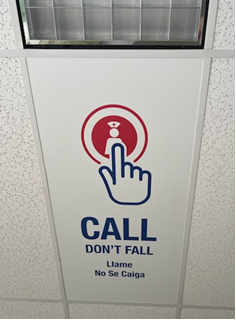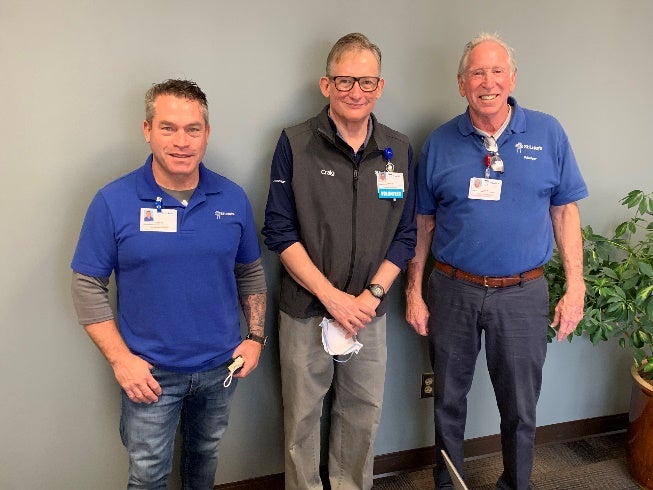Thinking outside the typical fall prevention bundle box
During the COVID-19 pandemic, St. Luke’s Meridian Medical Center in Meridian, Idaho experienced a rapid increase in falls with injury. The pandemic launched a whole new set of unique challenges that contributed to the steady increase of falls. Among them were a large percentage of patients in isolation, staffing concerns, and the absence of family members at the bedside due to visitation restrictions amid COVID-19 concerns.
In tracking data from the medical center, we found that the patient population in one of the medical-surgical units had a recorded 41 falls in five months to start the 2022 calendar year. During the first five months of that year, our top three trends were as follows:
- 51% of patients did not have a bed/chair alarm activated when indicated as a fall risk.
- 57% of patients did not use a call light prior to getting out of bed.
- 33% of patients had delirium/dementia.
It was also noted that many of these patient falls were related to personal belongings not being within reach, as well as patients not using the call light to avoid “bothering staff.”
What the research says
St. Luke’s historically has used a standardized bundle of interventions including bed alarms, chair alarms, armbands, sitters, non-skid socks, whiteboards, visual cues, etc. Although these interventions can be successful when fully implemented, these interventions may not always prevent a fall.
An article by Jennifer LeLaurin and Ronald Shorr, “Preventing Falls in Hospitalized Patients: State of the Science” published in Clinics in Geriatric Medicine journal, noted that, “There is now strong evidence that [bed] alarms are ineffective as a fall prevention maneuver in hospitals.”
The article notes, however, that they can be helpful in alerting staff when patients are out of bed or attempting to get out of bed thereby providing minimal assistance to reach the patient before a fall takes place.
The authors also note that fall risk identification efforts, sitters, patient education, intentional rounding and non-skid socks are all interventions that provide little evidence to actually “prevent” falls even when tested repeatedly. The Joint Commission in its 2015 Sentinel Event Alert echoes this sentiment stating, “significant, sustained reduction has proven elusive.”
Avoiding the pitfalls
With literature showing mixed results related to standard fall prevention strategies, St. Luke’s determined it was time to think outside the box. We were determined to explore additional options that were unique and innovative, cost-effective, and that would minimally impact standard workflows. More importantly, we wanted to mitigate the risk of falls, especially falls with injury, to our patients.
Upon the reinstatement of volunteer services at St. Luke’s (which was halted during the peaks of COVID-19), we were able to reinstitute our volunteer patient safety rounding program.
The volunteer safety program was designed to help with ensuring fall prevention bundle interventions are in place for patient(s) identified as a fall risk. Although the literature asserts that these interventions are essentially ineffective, we wanted to ensure that our policy was being followed consistently, especially considering that more than half of our falls from our population sample did not have a bed/chair alarm activated. Our goal was to customize the volunteer safety program to reduce patient falls.
 Simultaneously to the introduction of our volunteer safety program, we learned of another hospital that had implemented a ceiling tile above the patient bed that read “Call Don’t Fall.”
Simultaneously to the introduction of our volunteer safety program, we learned of another hospital that had implemented a ceiling tile above the patient bed that read “Call Don’t Fall.”
Intuitively, we hypothesized that this messaging would help remind patients (and families) who are in an unfamiliar environment or condition to use the call light. The team decided to incorporate something similar at St. Luke’s Meridian since it spoke directly to some of our trends (patients not using a call light prior to getting out of bed, as well as patients electing not to use the call light to avoid bothering staff).
We partnered with the nursing, building services and marketing teams to design a ceiling tile to pilot on our med-surg unit that experienced the most falls. The design includes the call light emblem in red to ensure it is noticeable.
 Making the proposal
Making the proposal
The proposal was a power plan to include both volunteer rounding and ceiling tiles —interventions that are not in the standard fall prevention bundle. Our goals were: ensure all fall prevention bundle components are in place consistently for fall risk patients; establish a new culture for our patients that our staff is not bothered by their calls (patient safety is our highest priority); and ultimately, make significant impact on our fall rate, especially injury falls.
In addition, we were hopeful that consistent volunteer rounding would help to cultivate a more positive patient experience.
The following details were included in our proposal:
Ceiling tiles
- Include “Call Don’t Fall” statement in both English and Spanish.
- Install in all rooms on med-surg unit.
- Promote culture change communicating that we want to be “bothered,” as patient safety is our highest priority and enhances the care experience.
Volunteer services
- Rounding pilot started on med-surg unit that also piloted the ceiling tile starting in September 2022.
- Round on pilot unit at least once a day.
- Round on all patients with fall risk except those who are in isolation, have behavioral issues or alerted mental status.
- Audit all fall prevention bundle items listed in our policy including:
- Yellow “Fall Risk” armband on patient;
- Yellow “Fall Risk” star magnet on door outside of the room;
- Fall risk indicated on whiteboard in the room;
- Bed/chair alarm activated;
- All personal items within arm’s reach, as well as call light; and
- Familiarity with the “Call Don’t Fall” signage. (Ask the patient and family if they understand the meaning.)
- Volunteers intervene as necessary when fall prevention components are not in place (i.e., place armband on patient if not present on round, activate bed/chair alarm if found in off position, etc.)
- All audit data is collected and shared for coaching and shared learnings.
- Overall contributes to a positive patient experience.
Observing the outcomes
We have been fortunate to have support from our partners in volunteer services on this project, especially since they have been instrumental in helping us capture data to determine its performance. Julia Koch, manager of the med-surg unit says that, “Volunteers have been an important part of our multipronged approach to improving patient safety and reducing falls.”
Since the start of our data monitoring in October of 2022 we have accomplished the following:
- Compliance on use of yellow armbands increased from 47% to as high as 65%.
- Compliance on use of bed alarms has increased from 60% to 91%.
- Patient familiarity with the “Call Don’t Fall” ceiling tile is average of 98%.
Another win we have seen is that, currently, no falls have been identified in rooms where the patient indicated that they were familiar with the ceiling tile.
Although it is very early in our data capturing timeline to determine if our interventions are impactful, we do know that from October 2022 to November 2022, falls dropped from an average of 16 to a total of nine on the med-surg unit.
Going forward, the team’s goal is to continue to monitor data for the next two quarters and update our project outcomes. We are optimistic that these cost-effective interventions will improve patient safety outcomes and experience.




